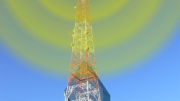You could look up the word “attenuation” either online or in a traditional dictionary if you want an answer to that question. You’d see that attenuation is ” a gradual loss in intensity of any kind of flux through a medium.” What, that’s not crystal clear?
Here’s a much better explanation that might Attenuation when you get less of something because something else is in the way. Here are some examples:
- If you hold your ears, your fingers are attentuating the sound.
- When you look in the distance on a foggy day, the fog is attenuating the stuff that’s far away.
- If your antenna or dish has to point through trees, the trees are attenuating the signal.
Those are real-world, see-and-hear examples of attenuation. We can also use an attenuator to cut the signal going through a wire. Something like this:
can cut the signal going through a wire just like putting your fingers in your ears. This one is a “variable” attenuator… it lets you control things. There are attenuators that work the same way all the time, but they don’t look as cool. Here’s an image showing one of those:
Why use an attenuator?
Most of the time, we want all the signal we can get, but sometimes if you are very close to something, it can be too powerful. So powerful that it can cause problems. Sometimes you’re strong enough that you can “pad” the signal a little bit and then get rid of stray signals you don’t want.
Attenuators are also used in home theatre receivers. If your volume numbers are listed -21, -30, etc. and the numbers get higher as the sound gets quieter, your receiver is actually amplifying to its full strength 100% of the time and then attenuating the signal if you want less sound. This makes it possible for the receiver to give you better quality at softer volumes.
What kind of attenuator should you use?
In general, fixed attenuators, which reduce the signal by a specific amount, are better than variable attenuators. Variable attenuators almost always introduce noise into the signal as the knob is turned. Higher quality attenuators don’t do as much to cut the quality of the signal, but there’s always going to be some issue there.
At their core, though, attenuators are really the same so you should pick the one that matches the kind of cable and signal you want to attenuate. Attenuators can be used to cut strong signals so that they don’t overload devices, or to make sure that signals are properly tailored for the cable run that you’re doing.
Get the right attenuator for your system. You can also get everything else you’ll want in order to live your best digital life! When you shop at Solid Signal, you’ll find it all in one place and with tons of free tech support!





